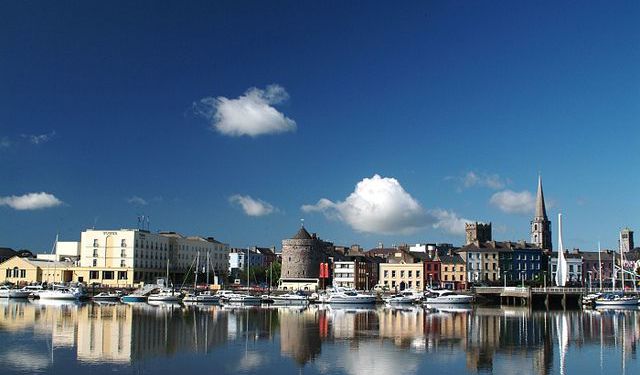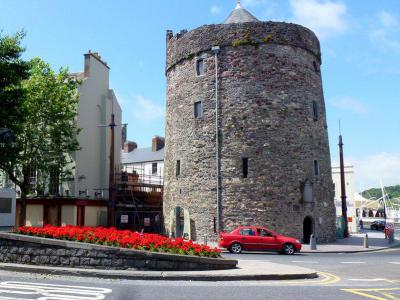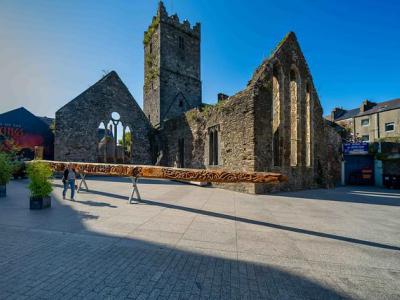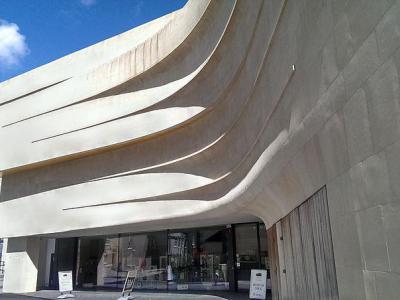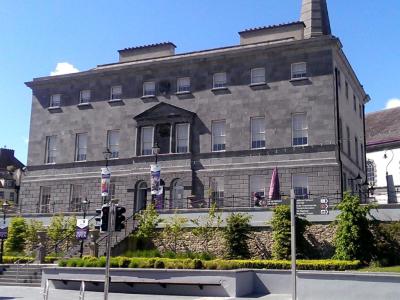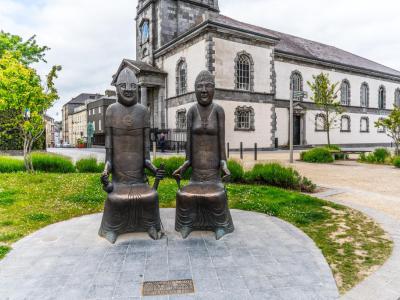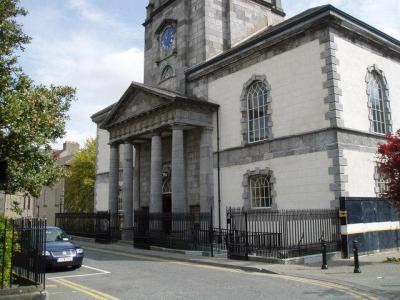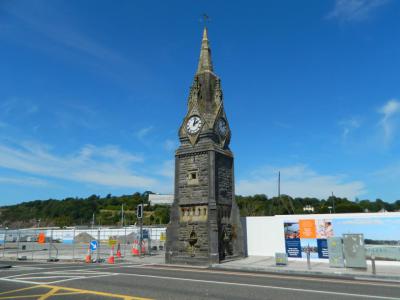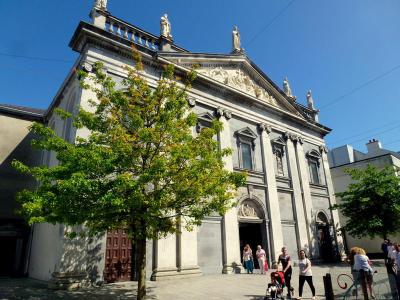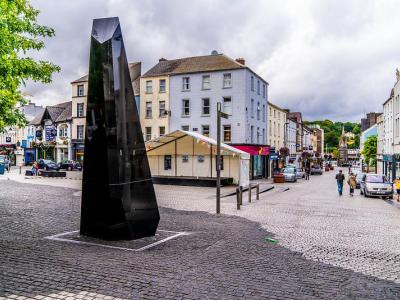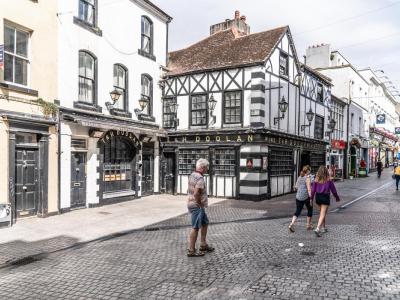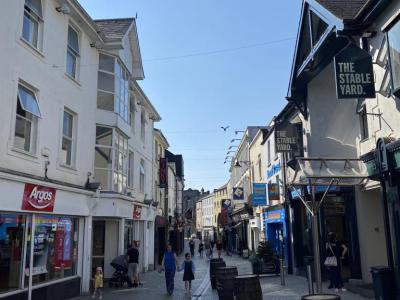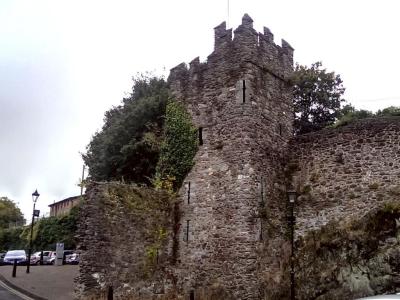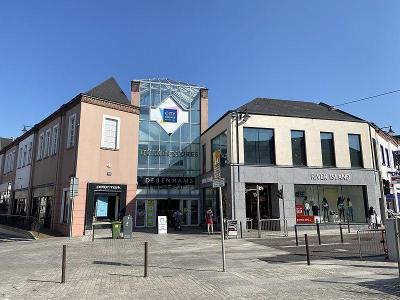Waterford Introduction Walking Tour (Self Guided), Waterford
Waterford is the oldest city in Ireland, whose stones still resonate with the echoes of its vibrant past. Historically the site of a Viking settlement, it emerged in 914 AD. The name “Waterford” derives from the Old Norse “Vedrarfjord,” meaning "ram-" or "windy fjord," which speaks to the city's strategic coastal location and tempestuous history.
Indeed, during the Middle Ages Waterford was besieged numerous times, including in 1170 when it was captured by Cambro-Norman forces led by Richard de Clare (Strongbow). This event was pivotal in the Norman invasion of Ireland, leading to King Henry II of England's arrival in 1171, declaring Waterford and Dublin royal cities.
Waterford flourished throughout the medieval period and successfully repelled several sieges in the 15th century, which ultimately earned it the motto “The Untaken City” (Urbs Intacta Manet). Despite enduring attacks and occupations, notably by Oliver Cromwell in 1650 and during the Williamite War in 1690, Waterford prospered in the 18th century, becoming a hub for glass-making and shipbuilding. The city’s resilience continued through various historical challenges, including participation in the Irish Civil War in 1922.
Although fairly small, Waterford has a lot to offer in terms of historic sights, boasting more of its original core than any other Irish city. At the heart of its historical narrative is the Old Town, a picturesque quarter where ancient stone walls and cobbled streets tell the tales of centuries gone by.
Renowned for its Viking Triangle, this area is defined by its 10th-century fortifications and anchored by the historical Reginald's Tower, the oldest urban civic building in Ireland. The Waterford Museum of Treasures, centrally located in the Viking Triangle, is divided between the Bishop's Palace, showcasing artifacts from 1700 to 1970, and an adjacent museum focusing on the city's Medieval period.
Rich in medieval architecture, this part of Waterford embodies a quieter charm compared to the city's modern commercial centers like John Roberts Square. The oldest pub in town, Doolan's, incorporates part of the original defense wall, adding to the historical ambiance.
As you explore Waterford, from its ancient beginnings to its lively present, each corner offers a tale, a sight, or a welcome. So, plan your visit now and become part of the city's continuing story with the help of this introductory walk designed to explore the most prominent sights of Waterford.
Indeed, during the Middle Ages Waterford was besieged numerous times, including in 1170 when it was captured by Cambro-Norman forces led by Richard de Clare (Strongbow). This event was pivotal in the Norman invasion of Ireland, leading to King Henry II of England's arrival in 1171, declaring Waterford and Dublin royal cities.
Waterford flourished throughout the medieval period and successfully repelled several sieges in the 15th century, which ultimately earned it the motto “The Untaken City” (Urbs Intacta Manet). Despite enduring attacks and occupations, notably by Oliver Cromwell in 1650 and during the Williamite War in 1690, Waterford prospered in the 18th century, becoming a hub for glass-making and shipbuilding. The city’s resilience continued through various historical challenges, including participation in the Irish Civil War in 1922.
Although fairly small, Waterford has a lot to offer in terms of historic sights, boasting more of its original core than any other Irish city. At the heart of its historical narrative is the Old Town, a picturesque quarter where ancient stone walls and cobbled streets tell the tales of centuries gone by.
Renowned for its Viking Triangle, this area is defined by its 10th-century fortifications and anchored by the historical Reginald's Tower, the oldest urban civic building in Ireland. The Waterford Museum of Treasures, centrally located in the Viking Triangle, is divided between the Bishop's Palace, showcasing artifacts from 1700 to 1970, and an adjacent museum focusing on the city's Medieval period.
Rich in medieval architecture, this part of Waterford embodies a quieter charm compared to the city's modern commercial centers like John Roberts Square. The oldest pub in town, Doolan's, incorporates part of the original defense wall, adding to the historical ambiance.
As you explore Waterford, from its ancient beginnings to its lively present, each corner offers a tale, a sight, or a welcome. So, plan your visit now and become part of the city's continuing story with the help of this introductory walk designed to explore the most prominent sights of Waterford.
How it works: Download the app "GPSmyCity: Walks in 1K+ Cities" from Apple App Store or Google Play Store to your mobile phone or tablet. The app turns your mobile device into a personal tour guide and its built-in GPS navigation functions guide you from one tour stop to next. The app works offline, so no data plan is needed when traveling abroad.
Waterford Introduction Walking Tour Map
Guide Name: Waterford Introduction Walking Tour
Guide Location: Ireland » Waterford (See other walking tours in Waterford)
Guide Type: Self-guided Walking Tour (Sightseeing)
# of Attractions: 14
Tour Duration: 2 Hour(s)
Travel Distance: 1.4 Km or 0.9 Miles
Author: elleng
Sight(s) Featured in This Guide:
Guide Location: Ireland » Waterford (See other walking tours in Waterford)
Guide Type: Self-guided Walking Tour (Sightseeing)
# of Attractions: 14
Tour Duration: 2 Hour(s)
Travel Distance: 1.4 Km or 0.9 Miles
Author: elleng
Sight(s) Featured in This Guide:
- Reginald's Tower
- French Church
- "King of the Vikings" 3D Experience
- Waterford Museum of Treasures
- Bishop's Palace
- Cathedral Square
- Christ Church Cathedral
- Clock Tower
- Cathedral of the Most Holy Trinity
- John Roberts Square
- Doolans Pub
- O’ Connell Street’s Cultural Quarter
- Beach Tower
- City Square Shopping Centre
1) Reginald's Tower (must see)
Reginald's Tower has stood as a sentinel of the city's history for over 800 years. Once described as "a massive hinge of stone connecting the two outstretched wings of the city," the tower has never fallen into ruin and has been continuously utilized throughout its long history. Originally, the site housed a wooden Viking fort, but the stone structure we see today was built by the Anglo-Normans, making it the most fortified point of Waterford's medieval defensive walls.
Throughout its history, Reginald's Tower has served multiple roles. During the reign of King John, it was used as a mint, producing coins for the region. Over the centuries, the tower also stored weapons, gunpowder, and cannons, reflecting the city's strategic importance and turbulent past. The tower's use evolved with the changing needs and political climates, serving various functions under many English monarchs.
Visitors to Reginald's Tower can explore its rich history by ascending the spiral stairs, where they will encounter a range of historical artifacts. These include the remains of a 19th-century prison cell, Viking relics, and the sword of the Chief Constable, whose family were the last known residents of the tower. This blend of exhibits provides a fascinating glimpse into the diverse uses and significant events associated with the tower over the centuries.
Today, Reginald's Tower houses one branch of the Waterford Museum of Treasures, specifically focusing on the town's vibrant Viking heritage. This museum provides visitors with an in-depth understanding of Waterford's early history, showcasing the influence of Viking settlers and the development of the city. As a key landmark, Reginald's Tower continues to be a symbol of Waterford's resilience and historical richness, attracting visitors eager to explore its storied past.
Throughout its history, Reginald's Tower has served multiple roles. During the reign of King John, it was used as a mint, producing coins for the region. Over the centuries, the tower also stored weapons, gunpowder, and cannons, reflecting the city's strategic importance and turbulent past. The tower's use evolved with the changing needs and political climates, serving various functions under many English monarchs.
Visitors to Reginald's Tower can explore its rich history by ascending the spiral stairs, where they will encounter a range of historical artifacts. These include the remains of a 19th-century prison cell, Viking relics, and the sword of the Chief Constable, whose family were the last known residents of the tower. This blend of exhibits provides a fascinating glimpse into the diverse uses and significant events associated with the tower over the centuries.
Today, Reginald's Tower houses one branch of the Waterford Museum of Treasures, specifically focusing on the town's vibrant Viking heritage. This museum provides visitors with an in-depth understanding of Waterford's early history, showcasing the influence of Viking settlers and the development of the city. As a key landmark, Reginald's Tower continues to be a symbol of Waterford's resilience and historical richness, attracting visitors eager to explore its storied past.
2) French Church
The French Church, also known as Greyfriars Abbey, is a significant historical site. It was built in 1241 by the Anglo-Norman Knight Sir Hugh Purcell. This former Franciscan friary is one of the earliest of its kind in Ireland, marking an important period in the country's ecclesiastical and cultural history. At the entrance, a monument honors Luke Wadding, a seventeenth-century priest from Waterford who was influential in the Catholic Church.
The church has a rich historical narrative, including hosting Richard II in 1394, who lodged there while planning his campaign against Irish clans in the Wicklow Mountains. It is notable as the site where four Irish clan chiefs-O'Conor Don, de Burgo, O'Brien, and O'Kennedy-surrendered to Richard II in 1395. This event was a significant moment in the Anglo-Irish relations of the time, illustrating the church's role not just in religious but also in political affairs.
A notable architectural feature added in the late fifteenth century is the bell tower, standing 25 meters high. The original bells were sold by Henry VIII in 1541, and it is believed they now reside in Christchurch Cathedral nearby. Despite the loss of its bells, the tower remains a prominent feature of the church, serving as a reminder of its former grandeur. The bell frame remained on the site until 1809, long after the church's primary religious functions had ceased.
The graveyard surrounding the French Church is the final resting place of several notable figures, including Sir Hugh Purcell, the church's founder, and Lord Richard Poer, Baron of Curraghmore, a staunch supporter of the Catholic faith. Also interred here is Sir Nicholas Walsh, a prominent judge in the Court of Common Pleas, and John Roberts, the distinguished architect responsible for many of Waterford's architectural treasures.
The church has a rich historical narrative, including hosting Richard II in 1394, who lodged there while planning his campaign against Irish clans in the Wicklow Mountains. It is notable as the site where four Irish clan chiefs-O'Conor Don, de Burgo, O'Brien, and O'Kennedy-surrendered to Richard II in 1395. This event was a significant moment in the Anglo-Irish relations of the time, illustrating the church's role not just in religious but also in political affairs.
A notable architectural feature added in the late fifteenth century is the bell tower, standing 25 meters high. The original bells were sold by Henry VIII in 1541, and it is believed they now reside in Christchurch Cathedral nearby. Despite the loss of its bells, the tower remains a prominent feature of the church, serving as a reminder of its former grandeur. The bell frame remained on the site until 1809, long after the church's primary religious functions had ceased.
The graveyard surrounding the French Church is the final resting place of several notable figures, including Sir Hugh Purcell, the church's founder, and Lord Richard Poer, Baron of Curraghmore, a staunch supporter of the Catholic faith. Also interred here is Sir Nicholas Walsh, a prominent judge in the Court of Common Pleas, and John Roberts, the distinguished architect responsible for many of Waterford's architectural treasures.
3) "King of the Vikings" 3D Experience
The "King of the Vikings" experience offers a unique and immersive journey into the world of Viking history through cutting-edge virtual reality technology. Available in English, French, and German, the experience brings visitors face-to-face with the legendary Viking warlords who founded Ireland's oldest city.
This attraction, touted as the world's first Viking Virtual Reality 3D Adventure, is set within a meticulously reconstructed Viking house, located amid the atmospheric ruins of a medieval monastery in Waterford's Viking Triangle. The replica Viking house, crafted using traditional building techniques, stands as an authentic representation of how Vikings lived, all while housed in the historical context of a 13th-century Franciscan friary.
The narrative of the "King of the Vikings" experience is deeply rooted in the historical events that shaped Waterford and Ireland during the Viking Age. For a century, Viking longships, known for their speed and maneuverability, raided monasteries and settlements across Ireland, seizing slaves and treasure. This period of turmoil gave way to a brief peace in 902 when Viking leaders were expelled from the country. However, this peace was short-lived. In 917, Reginald, a descendant of the famous Viking leader Ivar, returned to Waterford. He fortified the area, claimed the title of king, and re-established Viking dominance not only in Dublin but also extended his influence to England, becoming the 'King of York and all the foreigners of Ireland and Britain.'
Visitors to the "King of the Vikings" are transported back in time through virtual reality to witness the life of these formidable raiders, builders, and traders. The experience vividly illustrates the dual nature of the Vikings: as both fearsome warriors and skilled settlers who established towns and engaged in international trade. The immersive experience provides a tangible connection to the past, allowing participants to explore the intricacies of Viking life and understand the impact of their presence in Ireland and beyond.
This attraction, touted as the world's first Viking Virtual Reality 3D Adventure, is set within a meticulously reconstructed Viking house, located amid the atmospheric ruins of a medieval monastery in Waterford's Viking Triangle. The replica Viking house, crafted using traditional building techniques, stands as an authentic representation of how Vikings lived, all while housed in the historical context of a 13th-century Franciscan friary.
The narrative of the "King of the Vikings" experience is deeply rooted in the historical events that shaped Waterford and Ireland during the Viking Age. For a century, Viking longships, known for their speed and maneuverability, raided monasteries and settlements across Ireland, seizing slaves and treasure. This period of turmoil gave way to a brief peace in 902 when Viking leaders were expelled from the country. However, this peace was short-lived. In 917, Reginald, a descendant of the famous Viking leader Ivar, returned to Waterford. He fortified the area, claimed the title of king, and re-established Viking dominance not only in Dublin but also extended his influence to England, becoming the 'King of York and all the foreigners of Ireland and Britain.'
Visitors to the "King of the Vikings" are transported back in time through virtual reality to witness the life of these formidable raiders, builders, and traders. The experience vividly illustrates the dual nature of the Vikings: as both fearsome warriors and skilled settlers who established towns and engaged in international trade. The immersive experience provides a tangible connection to the past, allowing participants to explore the intricacies of Viking life and understand the impact of their presence in Ireland and beyond.
4) Waterford Museum of Treasures (must see)
The Waterford Museum of Treasures offers a rich, interactive experience for visitors, with a series of audio-visual presentations that enhance the exploration of its collections. The exhibits include rare and unique artifacts, such as the cap of maintenance awarded to the Mayor of Waterford by Henry VIII in 1536, a testament to the city's historical significance.
This museum complex comprises five distinct museums, each offering a unique glimpse into the city's rich history. Among these, the Viking Museum is housed in Reginald's Tower, the oldest civic building in Ireland, and showcases artifacts from Waterford's Viking heritage. Another highlight is the Bishop's Palace Museum, a 250-year-old Georgian building that presents artifacts from 17th-century Waterford to the present day.
The Medieval Museum stands out as the island's only purpose-built museum dedicated to the medieval era. Uniquely, it incorporates two historic chambers: the 13th-century Choristers’ Hall and the 15th-century Mayor’s Wine Vault.
As you begin your tour in the 13th-century Choristers' Hall, you are immediately transported back to a time of grandeur and historical significance. The hall, once an integral part of the medieval city's ecclesiastical and civic life, now serves as a showcase for some of Ireland's greatest medieval treasures. Among these are the Great Charter Roll, an artifact so significant that it was recently viewed by HM King Charles III and the Queen Consort.
Continuing the journey, the 15th-century Mayor's Wine Vault offers a glimpse into the storage practices of medieval times, where valuable wines and other goods were safeguarded. This vault is not only a fascinating architectural feature but also a treasure trove of medieval history. Here, visitors can marvel at the magnificent 15th-century cloth-of-gold church vestments, a testament to the artistic and cultural richness of the period.
This museum complex comprises five distinct museums, each offering a unique glimpse into the city's rich history. Among these, the Viking Museum is housed in Reginald's Tower, the oldest civic building in Ireland, and showcases artifacts from Waterford's Viking heritage. Another highlight is the Bishop's Palace Museum, a 250-year-old Georgian building that presents artifacts from 17th-century Waterford to the present day.
The Medieval Museum stands out as the island's only purpose-built museum dedicated to the medieval era. Uniquely, it incorporates two historic chambers: the 13th-century Choristers’ Hall and the 15th-century Mayor’s Wine Vault.
As you begin your tour in the 13th-century Choristers' Hall, you are immediately transported back to a time of grandeur and historical significance. The hall, once an integral part of the medieval city's ecclesiastical and civic life, now serves as a showcase for some of Ireland's greatest medieval treasures. Among these are the Great Charter Roll, an artifact so significant that it was recently viewed by HM King Charles III and the Queen Consort.
Continuing the journey, the 15th-century Mayor's Wine Vault offers a glimpse into the storage practices of medieval times, where valuable wines and other goods were safeguarded. This vault is not only a fascinating architectural feature but also a treasure trove of medieval history. Here, visitors can marvel at the magnificent 15th-century cloth-of-gold church vestments, a testament to the artistic and cultural richness of the period.
5) Bishop's Palace (must see)
Bishop's Palace is a Georgian-style mansion that was built in 1741. It served as the residence of the Church of Ireland bishops for over two centuries. Today, the palace has been transformed into a captivating museum, offering visitors a glimpse into the history, culture, and craftsmanship of Waterford and its surroundings.
The architecture of Bishop's Palace is a fine example of Georgian design, characterized by its symmetrical facade, elegant proportions, and classical details. The building's interior boasts impressive period features, including ornate plasterwork, intricate woodcarvings, and grand staircases, all of which reflect the wealth and status of its former occupants.
Within the museum's walls, visitors can explore a diverse range of exhibits showcasing Waterford's rich cultural heritage. One of the highlights is the renowned Waterford Treasures collection, which includes exquisite artifacts dating back to the city's Viking and medieval past. Visitors can admire stunning examples of Waterford Crystal, for which the city is internationally renowned, as well as learn about the craftsmanship and techniques behind this revered art form.
The museum also offers insights into the social history of Waterford, with exhibits covering topics such as trade, industry, and daily life throughout the centuries. Interactive displays, multimedia presentations, and informative guided tours provide visitors of all ages with an engaging and educational experience.
The architecture of Bishop's Palace is a fine example of Georgian design, characterized by its symmetrical facade, elegant proportions, and classical details. The building's interior boasts impressive period features, including ornate plasterwork, intricate woodcarvings, and grand staircases, all of which reflect the wealth and status of its former occupants.
Within the museum's walls, visitors can explore a diverse range of exhibits showcasing Waterford's rich cultural heritage. One of the highlights is the renowned Waterford Treasures collection, which includes exquisite artifacts dating back to the city's Viking and medieval past. Visitors can admire stunning examples of Waterford Crystal, for which the city is internationally renowned, as well as learn about the craftsmanship and techniques behind this revered art form.
The museum also offers insights into the social history of Waterford, with exhibits covering topics such as trade, industry, and daily life throughout the centuries. Interactive displays, multimedia presentations, and informative guided tours provide visitors of all ages with an engaging and educational experience.
6) Cathedral Square
Cathedral Square, known as the city's tourist heart, showcases Waterford's rich history and vibrant cultural scene. The buildings around Cathedral Square, once abandoned, are now part of an urban renewal project aimed at transforming these historic structures into modern living spaces and retail units, blending old and new seamlessly.
At the center of Cathedral Square stands a monumental neo-Classical cathedral, designed by John Roberts (1712-1796), who uniquely designed both the Church of Ireland and Catholic cathedrals in the city. The cathedral's construction includes fragments of an earlier 1210 church, highlighting the site's long-standing ecclesiastical significance, dating back to 1096.
Situated in the Cathedral Close, a notable sculpture commemorates the historic marriage of Strongbow and Aoife, a pivotal event in Irish history. Unveiled in 2014, the sculpture marks the union of Richard de Clare, known as Strongbow, and Aoife McMurrough, daughter of Dermot McMurrough, King of Leinster. This marriage, which took place in 1170 within Waterford City's Viking Triangle, significantly altered the course of Irish history, leading to the Norman invasion of Ireland.
The sculpture not only serves as a reminder of this crucial moment but also offers a picturesque spot for visitors to pause and reflect. Its location and historical significance make it a must-visit for those exploring Waterford, providing a unique photo opportunity and a chance to delve into the rich tapestry of Ireland's past.
At the center of Cathedral Square stands a monumental neo-Classical cathedral, designed by John Roberts (1712-1796), who uniquely designed both the Church of Ireland and Catholic cathedrals in the city. The cathedral's construction includes fragments of an earlier 1210 church, highlighting the site's long-standing ecclesiastical significance, dating back to 1096.
Situated in the Cathedral Close, a notable sculpture commemorates the historic marriage of Strongbow and Aoife, a pivotal event in Irish history. Unveiled in 2014, the sculpture marks the union of Richard de Clare, known as Strongbow, and Aoife McMurrough, daughter of Dermot McMurrough, King of Leinster. This marriage, which took place in 1170 within Waterford City's Viking Triangle, significantly altered the course of Irish history, leading to the Norman invasion of Ireland.
The sculpture not only serves as a reminder of this crucial moment but also offers a picturesque spot for visitors to pause and reflect. Its location and historical significance make it a must-visit for those exploring Waterford, providing a unique photo opportunity and a chance to delve into the rich tapestry of Ireland's past.
7) Christ Church Cathedral
Christ Church Cathedral is a prominent cathedral of the Church of Ireland, situated within the ecclesiastical province of Dublin. The cathedral's rich history dates back to the 11th century, when the first church was built on the site. This structure was replaced in 1210 by a Gothic cathedral, reflecting the architectural styles and religious influences of the period.
The history of Christ Church Cathedral is closely tied to the broader ecclesiastical developments in Ireland, particularly during the Irish Reformation. The Church of Ireland was established as the state church by a decree of the Irish Parliament, taking over most church properties, including Christ Church Cathedral. This transition marked a significant shift in religious and cultural heritage, with the cathedral maintaining many religious artifacts and architectural features, though some were later lost.
One of the most intriguing aspects of the cathedral's history involves the discovery of medieval vestments during the demolition of the old Gothic structure in 1773. These vestments, significant for their historical and religious value, were presented by the Anglican bishop at the time, the Rt Revd Richard Chenevix, to the Roman Catholic bishop, the Most Revd Peter Creagh. Today, these vestments are preserved and displayed in the Museum of Treasures in Waterford and the National Museum in Dublin, highlighting the cathedral's enduring connection to Ireland's religious and cultural history.
The history of Christ Church Cathedral is closely tied to the broader ecclesiastical developments in Ireland, particularly during the Irish Reformation. The Church of Ireland was established as the state church by a decree of the Irish Parliament, taking over most church properties, including Christ Church Cathedral. This transition marked a significant shift in religious and cultural heritage, with the cathedral maintaining many religious artifacts and architectural features, though some were later lost.
One of the most intriguing aspects of the cathedral's history involves the discovery of medieval vestments during the demolition of the old Gothic structure in 1773. These vestments, significant for their historical and religious value, were presented by the Anglican bishop at the time, the Rt Revd Richard Chenevix, to the Roman Catholic bishop, the Most Revd Peter Creagh. Today, these vestments are preserved and displayed in the Museum of Treasures in Waterford and the National Museum in Dublin, highlighting the cathedral's enduring connection to Ireland's religious and cultural history.
8) Clock Tower
Designed by Charles Tarrant, the Clock Tower is a significant example of mid-19th-century architecture. Built in 1863, during a period when Waterford was Ireland's busiest and most important industrial port, the Clock Tower symbolized the city's wealth and confidence. Originally known as 'The Fountain Clock,' it featured troughs for horses, serving both a practical and decorative purpose. The clock quickly became a beloved meeting point for Waterford residents, establishing itself as a central element of the city's landscape.
The Clock Tower's architectural details reflect its historical significance. Constructed on a square plan, the freestanding structure features a two-stage design with a broach spire. The walls, made of coursed rock-faced cut limestone, rest on a plinth inscribed with a benchmark, supported by stepped buttresses at the corners. The spire, crafted from granite ashlar, is topped with a wrought iron weathervane. The tower's design elements, including the pointed-arch door and square-headed window with granite surrounds, highlight the craftsmanship and attention to detail characteristic of the period.
The technical aspects of the Clock Tower's inner mechanisms for both the fountain and the clock continue to intrigue engineers and historians. The tower's intricate design and engineering reflect the city's historical significance as a center of trade and industry. This fascination with timepieces extends to Waterford's National Horological Museum, located on Greyfriars Street, which showcases a collection of the oldest Irish-made grandfather clocks, table clocks, and watches in the world.
Today, the Clock Tower remains an iconic symbol of Waterford, set against a cobbled footpath that fronts the quay.
The Clock Tower's architectural details reflect its historical significance. Constructed on a square plan, the freestanding structure features a two-stage design with a broach spire. The walls, made of coursed rock-faced cut limestone, rest on a plinth inscribed with a benchmark, supported by stepped buttresses at the corners. The spire, crafted from granite ashlar, is topped with a wrought iron weathervane. The tower's design elements, including the pointed-arch door and square-headed window with granite surrounds, highlight the craftsmanship and attention to detail characteristic of the period.
The technical aspects of the Clock Tower's inner mechanisms for both the fountain and the clock continue to intrigue engineers and historians. The tower's intricate design and engineering reflect the city's historical significance as a center of trade and industry. This fascination with timepieces extends to Waterford's National Horological Museum, located on Greyfriars Street, which showcases a collection of the oldest Irish-made grandfather clocks, table clocks, and watches in the world.
Today, the Clock Tower remains an iconic symbol of Waterford, set against a cobbled footpath that fronts the quay.
9) Cathedral of the Most Holy Trinity
The Cathedral of the Most Holy Trinity serves as the cathedral church of the Roman Catholic Diocese of Waterford and Lismore. Notably, it is the oldest post-Reformation Catholic cathedral in Ireland, predating the Roman Catholic Relief Act of 1829 by 36 years. The site had previously been occupied by a chapel known locally as the 'Big Chapel,' built in 1693.
The cathedral was designed by the esteemed architect John Roberts in 1793, following the earlier Roman Catholic Relief Act of the same year. Roberts, a prominent figure in Waterford's architectural history, also designed the nearby Christ Church Cathedral, the Church of Ireland cathedral in the city. The construction of the cathedral was overseen by Rev. Dean Thomas Hearn, D.D., who played a crucial role in its development. Roberts was reportedly deeply involved in the building process, visiting the site daily and ultimately succumbing to an illness contracted within the unfinished structure.
A significant feature of the Cathedral of the Most Holy Trinity is its pipe organ, crafted in 1858 by the renowned London firm William Hill & Sons. This organ is the third to be installed in the cathedral, with the first originating from the 'Big Chapel' in 1773 and later transferred to the new building. The second organ, a one-manual instrument, was built in 1826 by Calvin and William Porter Draper, who operated a workshop in Manor Street.
The cathedral was designed by the esteemed architect John Roberts in 1793, following the earlier Roman Catholic Relief Act of the same year. Roberts, a prominent figure in Waterford's architectural history, also designed the nearby Christ Church Cathedral, the Church of Ireland cathedral in the city. The construction of the cathedral was overseen by Rev. Dean Thomas Hearn, D.D., who played a crucial role in its development. Roberts was reportedly deeply involved in the building process, visiting the site daily and ultimately succumbing to an illness contracted within the unfinished structure.
A significant feature of the Cathedral of the Most Holy Trinity is its pipe organ, crafted in 1858 by the renowned London firm William Hill & Sons. This organ is the third to be installed in the cathedral, with the first originating from the 'Big Chapel' in 1773 and later transferred to the new building. The second organ, a one-manual instrument, was built in 1826 by Calvin and William Porter Draper, who operated a workshop in Manor Street.
10) John Roberts Square
John Roberts Square, a pedestrianized area in the heart of Waterford, serves as a key focal point of the city's modern commercial center. Named after the notable Waterford architect John Roberts, the square is formed at the junction of Barronstrand Street, Broad Street, and George's Street. Locally, it is often referred to as "Red Square," a nickname that originated from the distinctive red paving used when the area was first closed to traffic, giving the square a vibrant and inviting atmosphere.
A notable feature of John Roberts Square is a black granite sculpture created by Eileen MacDonagh, a renowned Irish sculptor born in Geevagh, County Sligo, in 1956. MacDonagh has been active in the field of sculpture since the 1980s, gaining recognition for her contributions to the arts in Ireland. Her election to Aosdána in 2004, an Irish organization that honors artists who have made a significant contribution to the arts, highlights her impact and the esteem in which her work is held.
The square's location, close to other significant landmarks such as Arundel Square and the City Square shopping center, makes it a central and bustling area, frequented by both locals and tourists. The combination of commercial activity and cultural elements enriches the urban landscape and provides a dynamic space for public gatherings, shopping, and cultural experiences.
A notable feature of John Roberts Square is a black granite sculpture created by Eileen MacDonagh, a renowned Irish sculptor born in Geevagh, County Sligo, in 1956. MacDonagh has been active in the field of sculpture since the 1980s, gaining recognition for her contributions to the arts in Ireland. Her election to Aosdána in 2004, an Irish organization that honors artists who have made a significant contribution to the arts, highlights her impact and the esteem in which her work is held.
The square's location, close to other significant landmarks such as Arundel Square and the City Square shopping center, makes it a central and bustling area, frequented by both locals and tourists. The combination of commercial activity and cultural elements enriches the urban landscape and provides a dynamic space for public gatherings, shopping, and cultural experiences.
11) Doolans Pub
T & H Doolans is Waterford’s oldest tavern and a quintessential stop for anyone visiting the city. Established in 1710, this traditional Irish pub offers a rich blend of history, culture, and entertainment. The pub's ambiance is deeply rooted in Waterford’s heritage, with parts of its internal walls dating back to the 14th century, originally part of the old city walls. This historical setting provides a unique backdrop for patrons looking to experience an authentic Irish pub atmosphere.
Renowned for its live traditional Irish music, T & H Doolans has built a reputation as a premier venue for both local and international musicians. The pub hosts nightly sessions of "trad" music, a vibrant form of Irish folk music that brings together instruments like fiddles, flutes, and bodhráns in spirited performances. This has made it a must-visit spot for music lovers and tourists seeking a genuine Irish cultural experience. The pub's warm and inviting environment has attracted famous artists such as Sinead O’Connor, The Pogues, and The Clancy Brothers, the latter of whom were once owners of the establishment.
In addition to its musical offerings, T & H Doolans serves traditional Irish food, making it a great spot for a full cultural immersion. Patrons can enjoy hearty Irish dishes while soaking in the lively music and historic surroundings. The pub's dedication to preserving traditional Irish culture and music has made it a beloved institution in Waterford, attracting visitors from around the world.
Renowned for its live traditional Irish music, T & H Doolans has built a reputation as a premier venue for both local and international musicians. The pub hosts nightly sessions of "trad" music, a vibrant form of Irish folk music that brings together instruments like fiddles, flutes, and bodhráns in spirited performances. This has made it a must-visit spot for music lovers and tourists seeking a genuine Irish cultural experience. The pub's warm and inviting environment has attracted famous artists such as Sinead O’Connor, The Pogues, and The Clancy Brothers, the latter of whom were once owners of the establishment.
In addition to its musical offerings, T & H Doolans serves traditional Irish food, making it a great spot for a full cultural immersion. Patrons can enjoy hearty Irish dishes while soaking in the lively music and historic surroundings. The pub's dedication to preserving traditional Irish culture and music has made it a beloved institution in Waterford, attracting visitors from around the world.
12) O’ Connell Street’s Cultural Quarter
O’Connell Street, located near the quays and port of Waterford, is steeped in a rich industrial heritage that dates back to the 1600s. This historic street became home to the first Quakers who settled in Waterford in 1655, fleeing persecution and establishing businesses in the area. Notably, O’Connell Street was where the Jacob family invented the first cream cracker and where the Penrose family founded the world-renowned Waterford Crystal in 1783. These pioneering families contributed significantly to the street's legacy as a center of innovation and craftsmanship.
Today, O’Connell Street is a vibrant and dynamic part of Waterford's city center, known as the Cultural Quarter. This area celebrates creativity and cultural diversity, offering a lively atmosphere filled with art and expression. The street is adorned with large-scale urban art, a testament to its embrace of contemporary culture. Each year, the Waterford Walls festival invites internationally renowned street artists to contribute their work, transforming the street into an open-air gallery of vibrant murals that captivate both locals and visitors.
In addition to its artistic flair, O’Connell Street boasts some of Waterford's most charming traditional Irish pubs. Among them is Thomas Maher’s pub, the oldest in the city, which has a storied past of once serving only men. Today, it welcomes everyone to enjoy a drink, such as their famed whiskey mac, while listening to tales of Waterford's rich history. Just across the street, Tully’s Bar offers a great selection of craft beers and whiskeys, making it a popular spot for pub-goers who often find themselves moving between Tully’s and Thomas Maher’s throughout the night.
O’Connell Street also features a variety of ethnic food stores and unique retail outlets, adding to its eclectic charm. Souk Dalma, one of the newer additions to the street, offers stylish brands and accessories, reflecting the area's embrace of both tradition and modernity.
Today, O’Connell Street is a vibrant and dynamic part of Waterford's city center, known as the Cultural Quarter. This area celebrates creativity and cultural diversity, offering a lively atmosphere filled with art and expression. The street is adorned with large-scale urban art, a testament to its embrace of contemporary culture. Each year, the Waterford Walls festival invites internationally renowned street artists to contribute their work, transforming the street into an open-air gallery of vibrant murals that captivate both locals and visitors.
In addition to its artistic flair, O’Connell Street boasts some of Waterford's most charming traditional Irish pubs. Among them is Thomas Maher’s pub, the oldest in the city, which has a storied past of once serving only men. Today, it welcomes everyone to enjoy a drink, such as their famed whiskey mac, while listening to tales of Waterford's rich history. Just across the street, Tully’s Bar offers a great selection of craft beers and whiskeys, making it a popular spot for pub-goers who often find themselves moving between Tully’s and Thomas Maher’s throughout the night.
O’Connell Street also features a variety of ethnic food stores and unique retail outlets, adding to its eclectic charm. Souk Dalma, one of the newer additions to the street, offers stylish brands and accessories, reflecting the area's embrace of both tradition and modernity.
13) Beach Tower
The Beach Tower is a notable 15th-century crenelated structure that forms part of the city's historic defenses. Situated on a rocky outcrop overlooking the River Suir, this tower was strategically positioned to serve as a natural defensive point. The location provided crucial oversight, with uninterrupted views upriver towards Granagh Castle and downriver beyond Reginald's Tower. Such vantage points were vital for monitoring potential threats, particularly the feared Spanish landings during periods of heightened tension.
As an observation post, the Beach Tower played a significant role in safeguarding the city. Its elevated position allowed for vigilant monitoring of the river and the city's docks, ensuring that any approaching dangers could be spotted and addressed promptly. The tower's design, featuring a rectangular shape with corner bastions, is characteristic of the bastion citadels constructed during the early 17th century, reflecting the military architectural styles of that period in Ireland.
The Beach Tower's historical significance is further underscored by its evolution over time. Initially constructed in the 15th century, it underwent substantial rebuilding in the early 17th century to enhance its defensive capabilities. This adaptation reflects the changing needs and technological advancements of the time, as well as the continuous efforts to protect Waterford from potential threats. Today, the Beach Tower stands as a testament to Waterford's rich history, offering a glimpse into the city's past defensive strategies and architectural heritage.
As an observation post, the Beach Tower played a significant role in safeguarding the city. Its elevated position allowed for vigilant monitoring of the river and the city's docks, ensuring that any approaching dangers could be spotted and addressed promptly. The tower's design, featuring a rectangular shape with corner bastions, is characteristic of the bastion citadels constructed during the early 17th century, reflecting the military architectural styles of that period in Ireland.
The Beach Tower's historical significance is further underscored by its evolution over time. Initially constructed in the 15th century, it underwent substantial rebuilding in the early 17th century to enhance its defensive capabilities. This adaptation reflects the changing needs and technological advancements of the time, as well as the continuous efforts to protect Waterford from potential threats. Today, the Beach Tower stands as a testament to Waterford's rich history, offering a glimpse into the city's past defensive strategies and architectural heritage.
14) City Square Shopping Centre
City Square Shopping Centre, located in the heart of Waterford facing Arundel Square, is a central hub for shopping and leisure in the city. With over 30 stores, the centre caters to a diverse range of shopping needs, from fashion and beauty to homewares and technology. Major retailers such as Debenhams, River Island, Dunnes Stores, Next, and Champion Sports anchor the centre, providing a comprehensive shopping experience for men, women, and children alike.
Beyond its array of fashion outlets, City Square Shopping Centre also hosts a variety of shops that cater to health, beauty, wellness, kids, and tech enthusiasts. This makes it a convenient one-stop destination for both locals and visitors. The presence of stores offering books, homewares, and other essentials further enhances the appeal, ensuring that shoppers can find everything they need under one roof.
For those looking to take a break from shopping, the centre boasts a selection of cafes and restaurants, including Cafe Kylemore, Shake Shack, and The Brasserie. These dining options provide a perfect spot for relaxation and refreshment, making the shopping experience more enjoyable and complete.
Conveniently situated near the quays, City Square Shopping Centre also offers covered parking for 500 cars, making it easily accessible. This combination of shopping variety, dining options, and practical amenities establishes City Square Shopping Centre as a key retail destination in Waterford, blending convenience with a vibrant shopping atmosphere.
Beyond its array of fashion outlets, City Square Shopping Centre also hosts a variety of shops that cater to health, beauty, wellness, kids, and tech enthusiasts. This makes it a convenient one-stop destination for both locals and visitors. The presence of stores offering books, homewares, and other essentials further enhances the appeal, ensuring that shoppers can find everything they need under one roof.
For those looking to take a break from shopping, the centre boasts a selection of cafes and restaurants, including Cafe Kylemore, Shake Shack, and The Brasserie. These dining options provide a perfect spot for relaxation and refreshment, making the shopping experience more enjoyable and complete.
Conveniently situated near the quays, City Square Shopping Centre also offers covered parking for 500 cars, making it easily accessible. This combination of shopping variety, dining options, and practical amenities establishes City Square Shopping Centre as a key retail destination in Waterford, blending convenience with a vibrant shopping atmosphere.
The Most Popular Cities
/ view all
